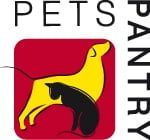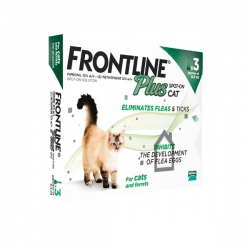Frontline Plus Spot On Cat And Ferret 3 Pipette
Stock: Discontinued Line
Presentation
Spot-on solution. Clear amber solution.
Composition
Each pipette of 0.5 ml contains:
Active substances:
Fipronil 50.00 mg
(S)-methoprene 60.00 mg
Excipients:
Butylhydroxyanisole (E320) 0.10 mg
Butylhydroxytoluene (E321) 0.05 mg
Clinical Particulars
Target species
Cats and Ferrets
Indications for use
In cats:
- To be used against infestations with fleas, alone or in association with ticks and/or biting lice.
- Elimination of fleas (Ctenocephalides spp.). Insecticidal efficacy against new infestations with adult fleas persists for 4 weeks. Prevention of the multiplication of fleas by inhibiting the development of eggs (ovicidal activity), larvae and pupae (larvicidal activity) originating from eggs laid by adult fleas for six weeks after application.
- Elimination of ticks (Ixodes ricinus, Dermacentor variabilis, Rhipicephalus sanguineus). The product has a persistent acaricidal efficacy for up to 2 weeks against ticks (based on experimental data)
- Elimination of biting lice (Felicola subrostratus).
In ferrets:
- To be used against infestations with fleas, alone or in association with ticks.
- Elimination of fleas (Ctenocephalides spp.). Insecticidal efficacy against new infestations with adult fleas persists for 4 weeks. Prevention of the multiplication of fleas by inhibiting the development of eggs (ovicidal activity), larvae and pupae (larvicidal activity) originating from eggs laid by adult fleas.
- Elimination of ticks (Ixodes ricinus). The product has a persistent acaricidal efficacy for 4 weeks against ticks (based on experimental data).
Contra-indications
In the absence of available data, the product should not be used on kittens less than 8 weeks old and/or weighing less than 1 kg. The product should not be used on ferrets less than 6 months old.
Do not use on sick (e.g. systemic diseases, fever) or convalescent animals.
Do not use in rabbits, as adverse reactions with even mortality could occur. In absence of studies, the use of the product is not recommended in non-target species.
Special warnings for each target species
Avoid the contact with the animal’s eyes. When treating infestations of parasites, all in-contact animals should be treated with an appropriate product at the same time.
Special precautions for use in animals
It is important to make sure that the product is applied to an area where the animal cannot lick it off and to make sure that animals do not lick each other following treatment. No data on the effect of bathing/shampooing on the efficacy of the product in cats and ferrets are available. However, based on information available for dogs shampooed as from 2 days after application of the product, it is not recommended to bath animals within 2 days after application of the product.
There may be an attachment of single ticks. For this reason a transmission of infectious diseases cannot be completely excluded if conditions are unfavourable.
Fleas from pets often infest the animal's basket, bedding and regular resting areas such as carpets and soft furnishings which should be treated, in case of massive infestation and at the beginning of the control measures, with a suitable insecticide and vacuumed regularly.
The potential toxicity of the product for kittens of less than 8 weeks of age in contact with a treated queen is not documented. Special care should be taken in this case.
Animals should be weighed accurately prior to treatment.
Special precautions to be taken by the person administering the product to animals
Keep pipettes in original packaging until ready to use.
This product can cause mucous membrane, skin and eye irritation. Therefore, contact of the product with mouth, skin and eyes should be avoided.
If the product is accidentally swallowed, seek medical advice immediately and show the package leaflet to the physician.
Animals or operators with a known hypersensitivity (allergy) to insecticides or alcohol should avoid contact with this product. Avoid contents coming into contact with the fingers. If this occurs, wash hands with soap and water.
After accidental exposure the eye should be rinsed carefully with pure water.
Wash hands after use.
Treated animals should not be handled until the application site is dry, and children should not be allowed to play with treated animals until the application site is dry. It is therefore recommended that animals are not treated during the day, but should be treated during the early evening, and that recently treated animals are not allowed to sleep with owners, especially children.
Do not smoke, drink or eat during application.
Adverse reactions
Do not overdose.
Cats:
Among the very rare suspected adverse reactions, transient skin reactions on the application site (scaling, local hair loss, itching, redness) and general itching or hair loss have been reported after use. Excessive salivation, reversible nervous signs (increased sensitivity to stimulation, depression, other nervous signs) or vomiting have also been observed after use. If licking occurs, a brief period of excessive salivation may be observed due mainly to the nature of the carrier.
Use during pregnancy, lactation or lay
Cats:
The product can be used during pregnancy.
Ferrets:
Laboratory studies in cats have not produced any evidence of teratogenic, foetotoxic or maternotoxic effects. The safety of the veterinary medicinal product has not been established in ferrets during pregnancy and lactation. Use only according to the risk-benefit assessment by the responsible veterinarian.
Method of administration
One pipette of 0.5 ml per cat, corresponding to a minimum recommended dose of 5 mg/kg for fipronil and 6 mg/kg for (S)-methoprene, by topical application to the skin. In the absence of safety studies, the minimum treatment interval is 4 weeks.
One pipette of 0.5 mL per ferret corresponding to a dose of 50 mg for fipronil and 60 mg for (S)-methoprene per ferret, by topical application to the skin. The minimum treatment interval is 4 weeks.
Overdose
The risk of experiencing adverse effects may increase with overdosing (see Adverse Reactions Section).
In cats:
No undesirable effects were observed in target animal safety studies in cats and kittens aged 8 weeks and older and weighing about 1 kg treated once a month at five times the recommended dose for six consecutive months.
Itching may occur following treatment.
Overdose application of the product will cause a sticky appearance of hairs at the treatment spot. However, should this occur, it will disappear within 24 hours post application.
In ferrets:
In ferrets aged 6 months and older and treated once every 2 weeks for four treatments, at five times the recommended dose, body weight loss was observed in some animals.
Pharmacological particulars
Pharmacotherapeutic group: Ectoparasiticides for topical use incl. insecticides QP53.
The product is an insecticidal and acaricidal solution for topical use, containing an association of an adulticidal active ingredient, fipronil, in combination with an ovicidal and larvicidal active ingredient, (S)-methoprene.
Pharmacodynamic properties
Fipronil is an insecticide and acaricide belonging to the phenylpyrazole family. It acts by interacting with ligand-gated chloride channels, in particular those gated by the neurotransmitter gamma-aminobutyric acid (GABA), thereby blocking pre- and post-synaptic transfer of chloride ions across cell membranes. This results in uncontrolled activity of the central nervous system and death of insects or acarines. Fipronil kills fleas within 24 hours, ticks (Dermacentor variabilis, Rhipicephalus sanguineus, Ixodes scapularis, Ixodes ricinus, Haemaphysalis longicornis, Haemaphysalis flava, Haemaphysalis campanulata) and lice within 48 hours post-exposure.
(S)-Methoprene is an insect growth regulator (IGR) of the class of compounds known as juvenile hormone analogues that inhibit the development of immature stages of insects. This compound mimics the action of juvenile hormone and causes impaired development and death of the developing stages of fleas. The on-animal ovicidal activity of (S)-methoprene results from either direct penetration of the eggshell of newly laid eggs or from absorption through the cuticle of the adult fleas. (S)-methoprene is also effective in preventing flea larvae and pupae from developing, which prevents contamination of the environment of treated animals with the immature stages of fleas.
Disposal
Any unused veterinary medicinal product or waste materials derived from such veterinary medicinal product should be disposed of in accordance with local requirements.
Fipronil and (S)-methoprene may adversely affect aquatic organisms. Do not contaminate ponds, waterways or ditches with the product or empty containers.
Legal Category
NFA-VPS
You can see a directory of all veterinary medicines here
We acquired this data from the Noah Compendium, please see a link to this product here
If you have any queries please contact one of our Animal Medicines Advisors here
Your Review: Note: HTML is not translated!
Rating: Bad Good
Enter the code in the box below:




 5* Trustpilot Reviews
5* Trustpilot Reviews